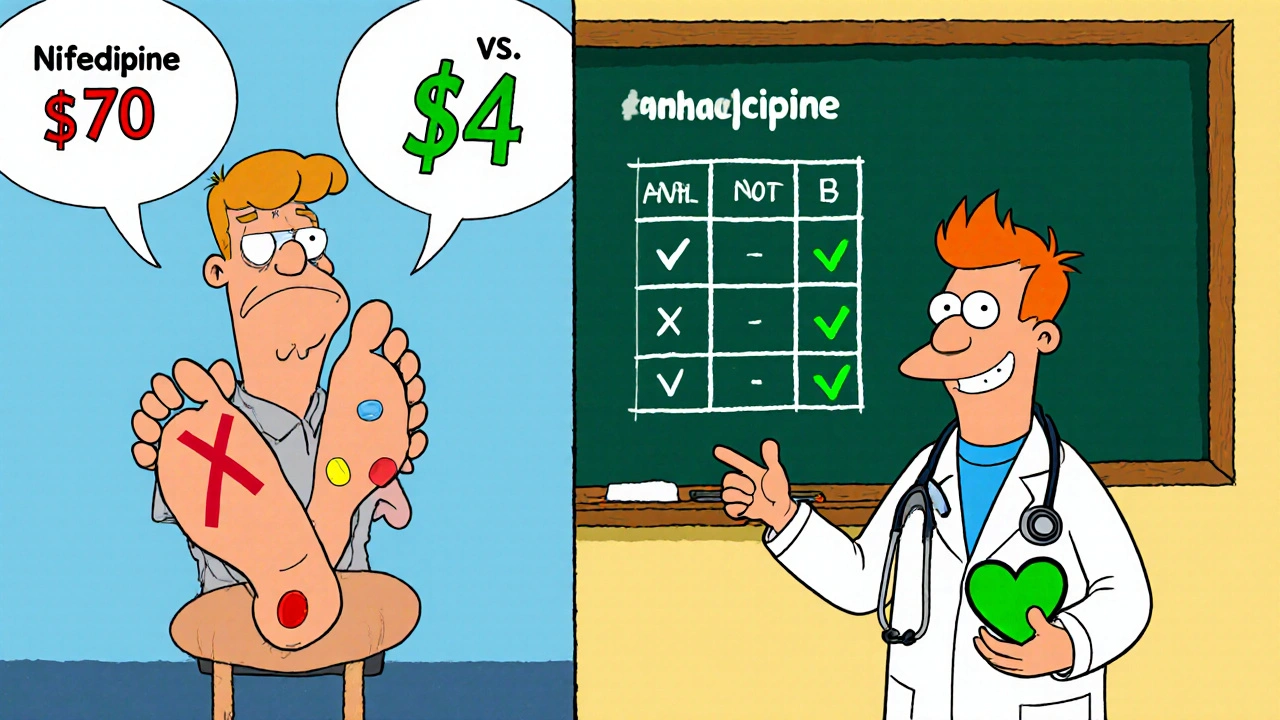Blood Pressure Medication Selector
Find the best blood pressure medication alternative based on your specific needs. This tool uses information from the article to help you identify options that may work better for you.
Your Health Profile
Your preferences
High blood pressure doesn’t care how much you read about it-it just keeps climbing. If you’ve been prescribed Procardia (nifedipine) and are wondering if there’s something better, cheaper, or easier to handle, you’re not alone. Thousands of people switch from nifedipine every year, often because of side effects, cost, or just not feeling right on it. The truth? There are several alternatives that work just as well-or better-for some people. But picking the right one isn’t about what’s trendy. It’s about what fits your body, your lifestyle, and your health goals.
What Procardia (Nifedipine) Actually Does
Procardia is the brand name for nifedipine, a calcium channel blocker that relaxes blood vessels to lower blood pressure and reduce chest pain. It works by blocking calcium from entering the muscle cells in your heart and arteries. Less calcium means less tightening of those vessels, which lowers pressure and improves blood flow.
Nifedipine comes in two forms: immediate-release (IR) and extended-release (ER). The IR version kicks in fast but needs to be taken 3-4 times a day. That’s why most doctors now prescribe the ER version-once daily, smoother effect, fewer spikes and crashes. It’s commonly used for hypertension and angina, and sometimes for preterm labor, though that’s off-label.
Side effects? Common ones include headaches, dizziness, flushing, swollen ankles, and constipation. For some, the swelling gets bad enough to stop taking it. Others feel their heart racing or get a pounding headache when they first start.
Why People Look for Alternatives
People stop nifedipine for real reasons, not just because they heard something online. One 2023 study in the Journal of Clinical Hypertension found that nearly 18% of patients on nifedipine switched medications within the first year due to side effects or lack of control. The most common complaints? Swelling in the legs and ankles (peripheral edema) and headaches.
Cost is another big driver. Even with insurance, nifedipine ER can cost $40-$70 a month without coupons. That’s not cheap if you’re on a fixed income. And if you’re taking it for angina, you might need it long-term-so the price adds up.
Then there’s the issue of effectiveness. Some people just don’t respond well to calcium channel blockers. Their blood pressure stays high, or they get worse symptoms. That’s when switching makes sense.
Top Alternatives to Procardia
There’s no single best alternative-it depends on your situation. But here are the five most commonly prescribed and well-studied options, ranked by how often they’re used and how well they match nifedipine’s benefits.
1. Amlodipine (Norvasc)
amlodipine, a long-acting calcium channel blocker, is the most common replacement for nifedipine. It’s similar in how it works but has a longer half-life-meaning one pill a day, steady effect, and fewer side effects like flushing or rapid heartbeat.
Studies show amlodipine causes less peripheral edema than nifedipine. In one trial, only 8% of patients on amlodipine reported swollen ankles, compared to 17% on nifedipine. It’s also cheaper-generic amlodipine costs as little as $4-$10 a month at most pharmacies.
Best for: People who want once-daily dosing, minimal side effects, and low cost. Not ideal if you have severe liver disease.
2. Lisinopril (Prinivil, Zestril)
lisinopril, an ACE inhibitor, works by blocking a hormone that narrows blood vessels. It’s not a calcium blocker-it’s a different class entirely. But it’s often used as a first-line treatment for high blood pressure, especially if you also have diabetes or kidney disease.
It doesn’t cause ankle swelling. Instead, it can cause a dry cough in about 10% of users. Some people also report a metallic taste. But for many, it’s gentler on the body than nifedipine.
It’s also protective for the kidneys and heart. If you’ve had a heart attack or have early kidney damage from diabetes, lisinopril is often preferred.
Best for: Diabetics, people with kidney issues, or those who can’t tolerate swelling from calcium blockers.
3. Losartan (Cozaar)
losartan, an ARB (angiotensin II receptor blocker), is similar to lisinopril but without the cough side effect. It’s a top choice for people who tried ACE inhibitors but couldn’t handle the cough.
Like lisinopril, losartan reduces protein in the urine and protects kidney function. It’s also linked to lower rates of stroke in certain populations. Side effects are mild: occasional dizziness or fatigue. Rarely, it can raise potassium levels, so your doctor will check that.
Cost? Generic losartan is about $5-$12 a month. Often cheaper than nifedipine ER.
Best for: People who need kidney protection and hate coughs. Good for those who can’t take ACE inhibitors.
4. Diltiazem (Cardizem, Tiazac)
diltiazem, another calcium channel blocker, is a good middle ground if you like the class but want fewer side effects. It’s less likely to cause swelling than nifedipine and has a calming effect on heart rate, which can help if you have atrial fibrillation or a fast heartbeat.
It’s often used for angina and high blood pressure together. Diltiazem ER is taken once or twice daily. Side effects can include fatigue, constipation, or slow heart rate-but those are less common than with nifedipine.
Best for: People with high blood pressure and heart rhythm issues. Not ideal if you have heart failure.
5. Hydrochlorothiazide (HCTZ)
hydrochlorothiazide, a thiazide diuretic, helps your body get rid of extra salt and water. It’s not a vasodilator like nifedipine, but it’s one of the oldest and most proven blood pressure pills.
It’s often combined with other drugs, but many people take it alone. It’s cheap-under $5 a month-and works well for older adults. Side effects include low potassium, dehydration, and increased urination. You’ll need to drink more water and maybe take a potassium supplement.
Best for: Older adults, people with fluid retention, or those on a tight budget. Not ideal if you have gout or kidney stones.

Comparison Table: Procardia vs. Alternatives
| Medication | Class | Dosing | Common Side Effects | Cost (Monthly, Generic) | Best For |
|---|---|---|---|---|---|
| Procardia (Nifedipine) | Calcium Channel Blocker | 1-2 times daily (ER) | Swelling, headaches, flushing, dizziness | $40-$70 | Angina, fast-acting pressure control |
| Amlodipine | Calcium Channel Blocker | Once daily | Mild swelling, fatigue | $4-$10 | General hypertension, low cost |
| Lisinopril | ACE Inhibitor | Once daily | Dry cough, dizziness, taste changes | $5-$12 | Diabetics, kidney protection |
| Losartan | ARB | Once daily | Dizziness, fatigue, high potassium | $5-$12 | People who can’t take ACE inhibitors |
| Diltiazem | Calcium Channel Blocker | Once or twice daily | Constipation, slow heart rate | $15-$30 | High blood pressure + heart rhythm issues |
| Hydrochlorothiazide | Diuretic | Once daily | Dehydration, low potassium, frequent urination | <$5 | Older adults, fluid retention, budget-conscious |
When to Stick With Procardia
Not everyone should switch. If nifedipine is working for you-your blood pressure is under control, you have no major side effects, and you’re not spending too much-then there’s no reason to change. Many people do fine on it for years.
Procardia is especially useful if you have severe angina or need quick relief from chest pain. The immediate-release form can be used in emergencies (though it’s rarely prescribed for that anymore due to risks).
If you’ve tried other drugs and they didn’t work, or if you’ve had a heart procedure and your doctor specifically recommended nifedipine, stick with it. Don’t switch just because someone online says it’s bad.

What to Ask Your Doctor
Before you ask for a switch, come prepared. Here are five questions to ask:
- Is my blood pressure really not controlled, or am I just feeling side effects?
- Could my swelling or headaches be from something else-like salt intake or standing too long?
- Do I have any other conditions (diabetes, kidney disease, heart rhythm issues) that make one drug better than another?
- Can we try a lower dose of nifedipine first instead of switching?
- What’s the cheapest option that still works for my health needs?
Doctors don’t always bring up cost. But if you say, “I can’t afford this,” they’ll often find a generic alternative or help you apply for patient assistance programs.
What Not to Do
Don’t stop nifedipine cold turkey. Stopping suddenly can cause rebound high blood pressure or chest pain. Always taper under medical supervision.
Don’t switch to something you saw on a TikTok video. Herbal supplements like hawthorn or garlic extract might sound natural, but they’re not proven to replace prescription meds. Some even interact dangerously with nifedipine.
And don’t assume all calcium channel blockers are the same. Amlodipine and diltiazem are different from nifedipine-not just in duration, but in how they affect your heart and blood vessels.
Final Thoughts
There’s no magic pill. Procardia works for some. Amlodipine works better for others. Lisinopril might be the right fit if you have diabetes. The goal isn’t to find the “best” drug-it’s to find the one that keeps your pressure down, doesn’t mess up your life, and fits your budget.
If you’re unhappy with nifedipine, talk to your doctor. Bring your blood pressure logs, note your side effects, and ask about alternatives. You don’t have to suffer through a drug that doesn’t suit you. But don’t make the switch alone. With the right guidance, you can find a better fit.
Is nifedipine the same as Procardia?
Yes. Procardia is the brand name for the drug nifedipine. Generic nifedipine works the same way and is much cheaper. Many people switch to generic to save money without losing effectiveness.
Can I switch from Procardia to amlodipine on my own?
No. Never switch blood pressure medications without your doctor’s guidance. Even though amlodipine is similar, the dosage and timing aren’t the same. Stopping nifedipine suddenly can cause dangerous spikes in blood pressure. Always taper under medical supervision.
Which alternative is cheapest?
Hydrochlorothiazide (HCTZ) is usually the cheapest, often under $5 a month. Lisinopril and losartan are also very affordable, typically $5-$12. Amlodipine is close behind at $4-$10. Procardia (nifedipine ER) is often the most expensive, especially without coupons.
Do any of these alternatives cause weight gain?
Nifedipine and amlodipine can cause fluid retention, which may lead to slight weight gain due to swelling. Lisinopril, losartan, and HCTZ don’t typically cause weight gain. In fact, HCTZ can cause slight weight loss from fluid loss. Diltiazem usually doesn’t affect weight.
Is it safe to take nifedipine with other heart meds?
It depends. Nifedipine can interact with beta-blockers, statins, grapefruit juice, and some antibiotics. Always tell your doctor and pharmacist about every medication and supplement you take. Grapefruit juice, in particular, can dangerously raise nifedipine levels in your blood.






Lexi Brinkley
November 8, 2025 AT 04:46Kelsey Veg
November 9, 2025 AT 05:56Lashonda Rene
November 9, 2025 AT 17:02Andy Slack
November 10, 2025 AT 23:21Rashmi Mohapatra
November 11, 2025 AT 18:33Abigail Chrisma
November 11, 2025 AT 23:38Ankit Yadav
November 12, 2025 AT 01:29Meghan Rose
November 13, 2025 AT 20:11Steve Phillips
November 14, 2025 AT 14:07Rachel Puno
November 16, 2025 AT 14:01Clyde Verdin Jr
November 18, 2025 AT 08:25Key Davis
November 18, 2025 AT 14:08Cris Ceceris
November 19, 2025 AT 15:26Erika Puhan
November 21, 2025 AT 05:03Edward Weaver
November 21, 2025 AT 14:07